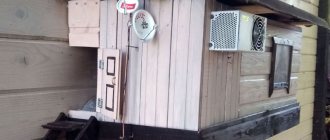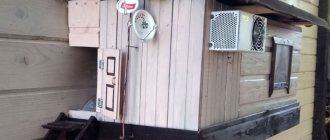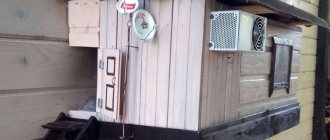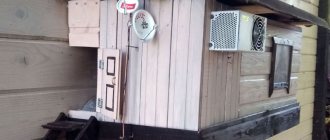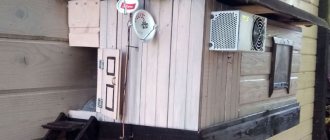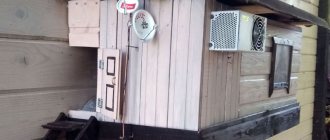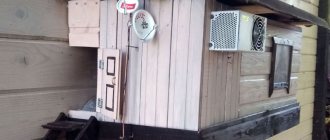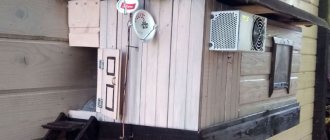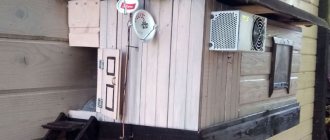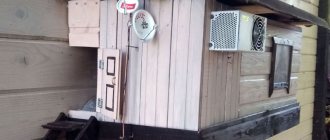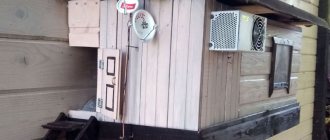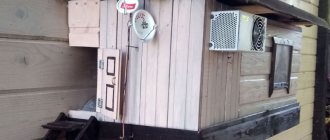Another homemade product for those who are bored at home
I needed a couple of antennas for digital, in places with “not the best reception”... I went shopping (this was before self-isolation - if it’s relatively budget-friendly, then it’s complete G. The more expensive one looks decent, but how it works is questionable.
- if it’s relatively budget-friendly, then it’s complete G. The more expensive one looks decent, but how it works is questionable.
I decided to make something homemade. It was somehow awkward to “twist” an antenna from a piece of cable (although rumor has it it works) - I wanted something simple, but more decent and advanced
In fact, the one I made is not radically more complicated, but somehow more “solid” or something. And the results of its testing were very encouraging, so I decided to sketch out a short description of what and how, in case someone else finds it useful 
... even if my street cats have a “normal” antenna on their house, what can you do without an antenna?!
The wire is not all finished yet, now we’ll assemble something!
In the places described, I previously used home-made broadband log-periodic antennas, probably since the “beginning of perestroika.” They worked well in analog and not only on UHF, but “for some reason, digital was too tough for them.” I didn’t really delve into the essence of the reasons, I removed them and began to think about what to replace them with. Here is one of them, waiting for a place in the trash
They worked well in analog and not only on UHF, but “for some reason, digital was too tough for them.” I didn’t really delve into the essence of the reasons, I removed them and began to think about what to replace them with. Here is one of them, waiting for a place in the trash
A little history
In the early 60s of the last century, our compatriot Kharchenko K.P. developed a simple flat zigzag antenna with good characteristics.
Copyright certificate No. 138277 for an invention called “Band directional antenna” was issued to Konstantin Pavlovich Kharchenko in 1961 (according to his application dated June 16, 1960). In the same year, materials were published in the magazine “Radio” for repetition by radio amateurs.
The antenna is not critical to materials and dimensions during manufacturing, has a simple good match with the reduction cable, and it successfully combines multiple elements of a common-mode antenna array with a single feed point.
AUGRA installation options
Installation of automatic control gear must comply with the following requirements:
- ensuring reliable fastening of the radio receiver to the car, preventing movement when exposed to various mechanical loads (wind, bending, etc.);
- ensuring tight contact with the body, which acts as a mass, which significantly reduces the level of interference and improves signal quality.
All options for installing a receiving radio antenna come down to three main methods for fixing the automatic control gear on a vehicle:
- mortise mounting using a through hole drilled in the roof or other part of the body;
- magnetic mount using a magnetic antenna base;
- a pin mount, which is a mechanical fixation of the antenna rod for a car radio on a special clamp-type bracket.
APRA mortise mount
The mounting pin of the radio antenna base is inserted into the through hole, and a nut is screwed onto it from inside the passenger compartment. The advantages of the “mortise fastening” method include:
- the strength of the device, reducing the likelihood of it being stolen;
- stability of the operating parameters of the antenna-feeder system after installation.
Among the disadvantages, the following circumstance is noted: the edges of the drilled hole are centers of corrosion of the metal body, therefore it is recommended to use standard technological holes.
Important! In the fastening area, it is necessary to strip the metal of paint to ensure reliable conductive contact of the nut, as an element of the antenna, with the metal of the car body. On rice
Below is the antenna base with a pin and a hole in the roof of the car prepared for installing the AUGRA
In Fig. Below is an antenna base with a pin and a hole in the roof of the car prepared for installing the AUGRA.
Antenna base for flush mounting
Magnetic mount APRA
The magnetic fastening of the antenna is provided by magnets located at its base - the sole. Magnets can be purchased separately from the antenna device. The most popular magnets are with diameters from 90 to 170 mm. The stability of the automatic control gear directly depends on the diameter of the magnet.
The antenna is attached to the magnet through two types of connectors:
- The DV connector is adapted to most antenna systems and allows for adjustment of the installation angle;
- The PL connector is more reliable in terms of maintaining strict vertical installation.
In Fig. Magnetic antenna mounts with DV and PL bases are shown below.
Magnetic antenna mounts with DV and PL bases
The advantages of the magnetic fastening method include the following points:
- ease of installation or dismantling;
- relatively high stability of the automatic control gear is ensured while maintaining the optimal size of the magnetic base;
- capacitive coupling of the magnetic base with the metal of the body creates a kind of imitation of “mass” necessary for the operation of the receiving antenna;
- the ability to move when setting up equipment.
Disadvantages include:
- low strength of fixation on the body;
- ease of abduction;
- the possibility of shifting, which leads to the need for additional adjustments.
APRA pin mount
For the technical implementation of the pin fastening, a clamp bracket is installed on the protruding part of the car body (fender, trunk, etc.), the clamping bolts of which, with their pointed ends, create mass contact necessary for high-quality radio reception.
In Fig. The pin mount on the bracket is shown below.
Pin mount
One of the advantages of this method is the possibility of fixing antenna devices on vehicles with non-uniform and protruding metal surfaces (truck cranes, open cars, special equipment).
The disadvantages include:
- low mechanical strength;
- difficult setup and coordination of automatic control gear.
Theory and calculations
The described antenna, in theory, has a horizontal “figure-of-eight” radiation pattern and a relatively high gain, which can be further increased by using a reflector/reflector.
To obtain maximum gain on all channels, it is necessary to make an antenna approximately in the middle of the range between the multiplexes used.
Finding (for calculations) the frequencies of multiplexes used in your region is easy,
for example, a request like “dvb-t2 channel frequencies” + “Krasnodar”
I found something like this:
The middle, between “my” two multiplexes, is 700 MHz - we will calculate the antenna at this frequency.
As a basis for calculating the dimensions of the antenna, we take the drawing of its author
Calculate the wavelength: λ = 300 / f [m]
300/700 = 0.428m, approximately 43cm length of each side of the rhombus
λ/4
=43/4= 10.75
The total length of the material we need (11cm*8=88cm) is less than a meter. The distance between the reduction contacts, where we will solder the cable, is 10-12mm (the standard value for this antenna for frequencies below 900 MHz).
I will make a simple antenna, without a reflector, however, to further increase the gain of this antenna, it is quite possible to install it behind it
for example, from a metal mesh/grill, foil material or simply a metal plate. Its dimensions should be approximately 20 percent larger than the dimensions of the antenna and it should be located at a distance of ƛmax/7. For my case: wavelength (channel 39) 300/618, it turns out...49/7= that is, about 7cm
For those who are too lazy to do the calculations themselves
— you can use an online calculator, the results will differ only slightly from those I received. Here, for example, this one - here you immediately enter the frequencies of two multiplexes and get the dimensions of the antenna (without a reflector) Or another option, with a reflector - I really want to note that in the second option a slightly different calculation option is used, different from the author’s. An antenna with angles other than 90° is assumed and the reflector distance is calculated as λ/8
To make the antenna sheet, it is recommended to use aluminum or copper (copper is easily soldered) with a diameter of 3 mm and higher - the larger the diameter, the more broadband the antenna is. You can use tubes; the thickness of the walls is not important, since only the surface of the material is used (in fact, you can wrap any dielectric with foil to obtain the required material). However, in my opinion, the easiest way is to buy a meter of large-gauge copper wire at an electrical supply store.
Kinds
The transition to digital broadcasting in Russia is at its peak, but its pace is somewhat exaggerated. Many families still watch, or are forced to watch, programs in the usual analogue quality. In places where there are television towers or repeaters, indoor TV antennas are not new. But is your old indoor antenna suitable for a digital signal? To receive digital broadcasting without installing an outdoor signal receiver, your indoor receiving device needs to catch decimeter waves or be broadband.
All-wave indoor antenna MV-UHF
There is an opinion that all-wave broadband catchers for “digital” are useless. In fact, devices of this type often demonstrate the opposite, because the problem lies not in their design itself (the main lobe of their radiation pattern is almost round), but much more often in the amplifiers with which they are equipped - without shielding, with a high noise level.
In some cases, the wide range of radio waves captured by an indoor broadband receiver can have a negative effect: the unwanted signals it receives will “clog” the DVB-T2 signal.
All-wave (MF-UHF) indoor antenna viva
A high-quality all-wave receiver has a chance to show itself in dense urban areas. Reflected television signals often occur within neighborhoods, and correct orientation of the directional model can be difficult.
The all-wave indoor television antenna is designed to receive all terrestrial television programs, both for analogue and digital broadcasting.
UHF indoor antenna
“Digital” broadcasts are carried out with radio wavelengths from 10 cm to 100 cm. A device whose instructions indicate that it is intended for the UHF range can be guaranteed to receive digital channels.
UHF (UHF) antenna
External devices of this type have an elongated design with a large number of crossbars (directors), due to which the signal reaching the vibrator is noticeably amplified. The radiation pattern of this receiving device has a narrow and elongated main lobe.
You may be interested in: Modern digital television
The indoor UHF antenna, being a compact device, nevertheless has an identical structure, but with fewer crossbars, which can be hidden under a plastic shell in order to give the structure an original look.
Antenna assembly
Let's remove the insulation from a piece of wire one meter long.
I got a wire with a diameter of 4.5mm
The tools you will need are a vice and a hammer. Measure approximately 11cm each and bend at an angle of 90°
The end result is to get such a “geometric” figure 
We cut off the excess and solder the ends. It should look something like this...
Solder the cable as shown in the photo.
We lay the cable along one side of the square and secure it with clamps. This arrangement of the cable is necessary for its coordination (there are different opinions, not everyone agrees with this statement).
When using a reflector, the antenna sheet at the extreme points of the squares can also be secured using metal stands, for example, soldered onto the remains of the same copper wire - there are points with zero potential (highlighted in green). In other places, fastening is allowed only through a dielectric.
From aluminum cans
This design is a little more complicated than the loop antenna described above, but it is much more efficient in operation. For assembly you will need:
- a couple of empty cans of any drinks (0.33, 0.5 l);
- old clothes hanger;
- tape, soldering iron, knife, ruler;
- TV cable, plug for connecting to the receiving device.
Manufacturing instructions:
- Remove the insulation from the cable at one end (length 5 cm), separate the central core and braid (twist the latter into a bundle).
- Tear off the tabs from the cans and solder the stripped wires to the places where they are attached - the central one to one can, the screen to the other (the conductors can simply be screwed to the holes where the tabs were attached, without soldering).
- Secure the jars with tape to the straight bar of the hanger at a distance of 7.5 cm from each other.
- Tape the cable to the hanger (where the hook is).
- Connect the TV plug.
Advantages and disadvantages
ease of manufacture - if difficulties arise with soldering, a twisted connection is acceptable (although undesirable);
the parts and materials used are not scarce or expensive;
possibility of installation outdoors;
fairly high efficiency - the antenna catches the signal at a distance from the transmitting center up to 10 km, depending on the presence/absence of obstacles, weather and other conditions.
it is necessary to strictly maintain the distance between the active elements - even a very small deviation threatens a significant loss of reception quality;
windage and low structural rigidity - on the street, such an antenna can deviate and unfold as a result of the influence of wind (if necessary, the device can be modified).
Connecting an antenna amplifier increases the range of a homemade device several times, but requires the organization of power circuits (9-12 volt unit) and protection from external influences (rain, sun) if the antenna is mounted outdoors.
Tests
And finally, a performance check and a rough
assessment of the quality of the resulting antenna.
In fact, everything is simple with the test - turn it on, it works! And to evaluate whether the game was “worth the candle,” let’s compare the parameters of the received signal from the manufactured antenna with the one I’m already using at the dacha, with a declared gain of 11dBi
And to evaluate whether the game was “worth the candle,” let’s compare the parameters of the received signal from the manufactured antenna with the one I’m already using at the dacha, with a declared gain of 11dBi
The antenna is installed in the attic of a country house, at a distance of approximately 16 km from the tower.
Signal level: factory stationary antenna on the left / homemade on the right
At first glance, the difference is only 1% (95 versus 94) - but this is not a completely correct comparison, since my external antenna is connected through a splitter, which further weakens the signal.
Installation safety precautions
For reliable operation of such antennas, it is necessary to place them above the ground at a level of 7-10 meters. Therefore, during installation it is necessary to strictly follow the safety rules:
- Do not install the structure in heavy rain or heavy fog.
- It is not advisable to go upstairs alone, especially in icy, cold, or snowy conditions.
- If it is necessary to climb a shaky structure or high-altitude work is carried out in dangerous places, then a fixed mounting belt is required.
After proper installation, homemade antennas work no worse than factory ones, with significant budget savings.
Assessing the performance of the antenna
Let's try to make a more correct comparison by connecting through the splitter input.
Well, in addition, for clarity, let’s add the number of participants List of antennas taking part in the comparison:
1. External antenna Funke BM 4551 external long-range,
declared gain, from some sources (bought at Yulmart), up to 16dB
2. There is an old UHF loop antenna, from TV Electronica 313d, I must say, despite its simplicity, it’s a very good antenna, that’s why it’s been preserved 
3. I went to the store and bought for comparison in the review one of the cheapest, such as a symmetrical vibrator (100% the most purchased by pensioners, due to the low price).
I will carry out all “measurements” at one point, located as close as possible to the external antenna - its location was experimentally selected based on the maximum signal, so we can say that the conditions are approximately the same
So, we have already seen the signal level from the external antenna at 95% (at the time of current measurements it showed 94%), we take it as a standard. All comparisons are made by connecting antennas to the input on the splitter, to which an external antenna is usually connected.
Loop antenna, from Electronics 82% on 39 multiplex and 66% on 60
Budget with “horns” - 62%/38% (on the verge of losing the broadcast)
- 62%/38% (on the verge of losing the broadcast)
Double square - 92% on both multiplexes, about a couple of percent less than the external one
Out of curiosity, I decided to check the work of the reflector, which is easy to make from any metal mesh, plate or even foil... It REALLY works noticeably! The level rose to 96%!, which is even higher than the stationary one, with a declared gain of 11dB.
The most interesting thing is the object that I used as a reflector! 
There was no foil in the house; the only thing available with a metal surface of the required size was... a laptop cover (I have a metal case). But the main thing is the result! It’s clear that I’m not going to “tie” the laptop to the antenna, and its amplification is enough for me without a reflector
Active or passive
All wave receivers can be divided into several groups: by type of design, method and location of installation, and other parameters. An indoor antenna for digital television is always a choice dilemma: should it be active or passive? A passive indoor antenna is one that does not have a built-in signal amplifier. According to the majority, this is the type of device you should choose for your home. This approach is based on the judgment that the length of the cable to the TV is short, only a few meters, so the device does not need an amplifier, because the signal in this section is not distorted. An active indoor antenna, that is, with a built-in amplifier, helps out when it itself is obviously low-power, and its installation is supposed to be at a considerable distance from the digital decoder. The cable will inevitably be subject to signal loss.
Television antennas with an amplifier have their supporters, but it is worth recognizing: the signal is received by the catcher itself, and not by its amplifier. How it copes with this task largely depends on its design, otherwise manufacturers would not be struggling with the best passive models, but would simply equip them with amplifiers, entrusting all the work associated with reception to them.
Amplifiers for indoor television antennas compensate for losses that occur on the way to the television receiver - receiver or TV. Each coaxial cable has a so-called attenuation coefficient, i.e., as the length of the cable increases, the level of the received signal decreases. If this distance is only a few meters, and the signal is obviously strong, then passive indoor antennas are quite suitable for watching digital television.
The situation is the opposite: there is a large house in a populated area with a good digital signal, one indoor radio wave receiver, cable splitters for several rooms, sockets and a wire length exceeding, for example, 40 meters. Each element - a splitter, a socket, and especially a long cable - causes a decrease in the signal. This is where it makes sense to use an active TV signal catcher.
When choosing between active and passive designs, use common sense: do not buy an expensive signal receiver with a powerful amplifier if you live five kilometers from a TV tower. The signal level of the active device may be so strong that it “overloads” the tuner or it produces strong noise and interference. As for the amplifier, it is a device that consumes electricity. Its consumption is small, but it is there. The active model only works when the amplifier is connected to the network. A device receiving waves with the amplifier turned off does not become passive; it cannot receive a signal at all.
Conclusion:
I can confidently recommend repeating it!
Simple, “cheap and tasty”... One of the simplest, indoor antenna mounts... with ordinary suction cups - if you’re lucky with the direction to the television center
The next antenna "recommended for repetition" is... log periodic
“Crazy hands” were with you. Good luck and good mood to everyone! ☕
Good luck and good mood to everyone! ☕
“Eight”, aka rhombus, aka “Z” shaped
Perhaps the most popular design for do-it-yourselfers. This fairly powerful Kharchenko antenna confidently receives meter and decimeter frequencies in analog and digital format. When the question arises: “How to make an antenna with your own hands?”, this option is first of all assumed.
What is its advantage? With compact dimensions, in most cases no amplifier is required. Unless you want to receive a signal on the 1st–3rd floor in a densely built-up microdistrict, where there are dozens of high-rise buildings between you and the television center.
How to make a homemade antenna without complex calculations? For a typical broadcast grid, there is a basic diamond arm size: 140 mm. Distance between wire connection points: 10–15 mm.
Kharchenko's antenna with such dimensions falls right in the middle of the typical broadcast range. If it is necessary to capture other channels (in some regions the grid may operate at non-standard frequencies), a wire structure can be made in several rows. The illustration shows a drawing from Radio magazine from 50 years ago.
Then the meter range was accepted, and the antennas had correspondingly gigantic dimensions. They were made from wire to reduce windage. This manufacturing technology requires patience and a large amount of material. Modern “homemade” people prefer a copper tube or an aluminum plate.
To make an indoor antenna using this technology, all you need is a piece of wire. The device hangs in the window opening (in the direction of the television center) and there is no need to worry about it being bent by the wind. Several diamonds can be made, and the reception range will be significantly expanded. An ideal option for digital television, which you can do yourself at the dacha or in a private home.
We amplify the signal without an amplifier
The reception efficiency (primarily this concerns the option under consideration) can be increased without additional electronics. It is enough to install a reflector or reflective screen. It will return television waves back to the antenna field, almost doubling the level. The canvas is located at a distance of 100 mm on the opposite side of the TV tower. A prerequisite is no electrical contact. Moreover, the reflector does not have to be solid. A series of metal tubes or openwork mesh is sufficient.
You can enhance the effect by using the “double biquadrate” design. The same dimensions apply, but the range remains the same. The extra length simply increases the signal strength.
